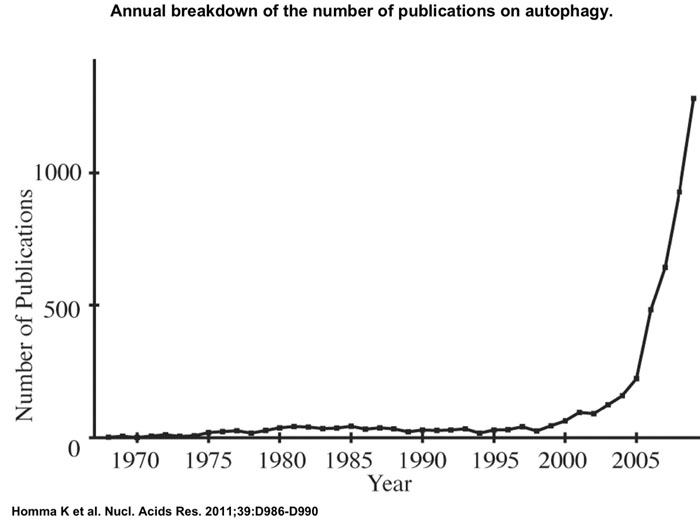|
Dear Doctor
In this issue of Biospeak, we focus on Autophagy (Auto-phagy)
(or are you one of the other 50% who pronounce it as Au-toph-agy?)
 The study of Autophagy has grown with extraordinary rapidity over the past decade, although it was first described nearly 50 years ago. Type Autophagy into PubMed and more than 7,000 records will keep you busy for hours. The highly ranked 'Autophagy' journal is now into its 7th year. The study of Autophagy has grown with extraordinary rapidity over the past decade, although it was first described nearly 50 years ago. Type Autophagy into PubMed and more than 7,000 records will keep you busy for hours. The highly ranked 'Autophagy' journal is now into its 7th year.
Programmed cell death was thought to be the primary role for autophagy, but this has now extended to repair mechanisms, nutrient starvation and infection control. It is not surprising that inappropriate autophagic activity is suspected in a host of different diseases.
If you have not yet caught up with the autophagy database, then here is the direct link http://tp-apg.genes.nig.ac.jp/autophagy/ . The number of proteins included has now reached 7,444.
|
| Is that extra cup of Starbucks really worth inducing apoptosis in your cells? |
|
Caffeine induces apoptosis by enhancement of autophagy via PI3K/Akt/mTOR/p70S6K inhibition Saiki et al, Autophagy 2011 Feb;7(2):176-87
Caffeine is well known to induce apoptosis, but whether it is associated with other cell death mechanisms, such as autophagy was not known. Saiki and colleagues have now demonstrated that the number of autophagosomes is increased by the action of caffeine, probably involving an inhibition of Akt/mTOR/p70S6K pathway and activation of the ERK1/2 pathway. Atg7 is involved, as the authors used siRNA in knockdown experiments to probe the cellular responses. Their findings provide support for the use of caffeine in the treatment of certain tumors as well as point to a potential new target for the regulation of apoptosis.
The authors have not indicated whether their consumption of caffeine has diminished! |
|
Targeting autophagy for the treatment of ALS |
|
Targeting autophagy in ALS: A complex mission M. Nassif and C. Hetz. Autophagy 7(4): 450-453, April, 2011
Here at Biosensis we are interested in neurodegenerative diseases including ALS, so this new review discussing potential autophagy-focused treatments for this terrible disease caught our attention. The authors argue cogently that until it is possible to define whether autophagy acts as an active survival pathway, operates as a pathological mechanism or has a 'dual dynamic' role in the disease process, it will not be possible to progress into therapeutic interventions. The fact that numerous studies have now shown that stimulation or inhibition of autophagy can be either detrimental or useful in rescuing cells affected by a disease process certainly enhances their argument. |
| Enhancing autophagy to treat Alzheimer's disease |
|
A small-molecule enhancer of autophagy decreases levels of A{beta} and APP-CTF via Atg5-dependent autophagy pathway Tian et al, FASEB J. 2011 Mar 2
Nobel Laureate, Paul Greengard, won his prize in 2000 for contributions to understanding cellular signalling (see a brief autobiography at http://nobelprize.org/nobel_prizes/medicine/laureates/2000/greengard-autobio.html). It is therefore not surprising to see his work continue in the field of autophagy. This study has focused on pathways that may be targeted by potential pharmaceuticals to benefit Alzheimer's disease patients. Using this approach Atg5, Beclin1 and Ulk1 were shown to be involved in the degradation of Abeta peptide and APP-CTF. A small molecule enhancer of rapamycin, SMER28, is seen as a possible therapeutic for Alzheimer's disease.
PS. Paul Greengard turns 86 this year. Keep researching! |